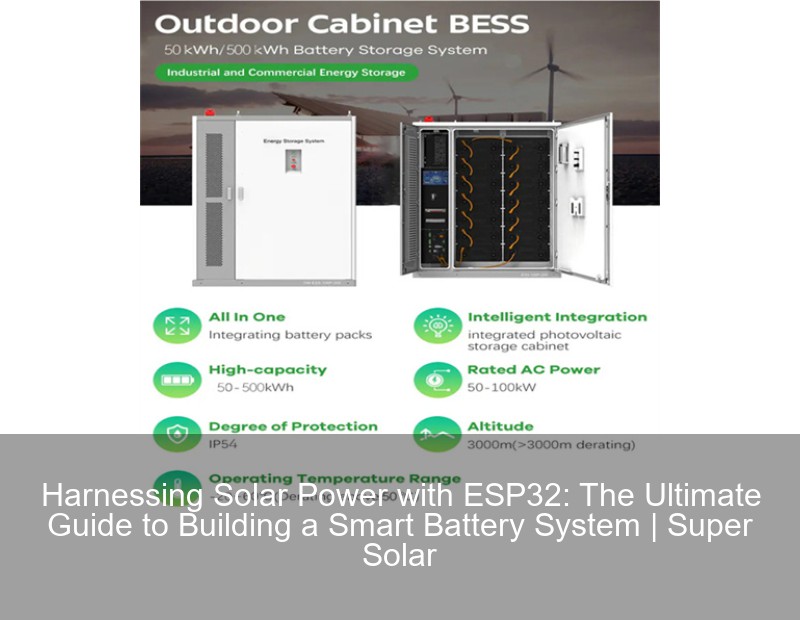Harnessing Solar Power with ESP32: The Ultimate Guide to Building a Smart Battery System

Why ESP32 and Solar Batteries Are a Match Made in Tech Heaven
Let’s face it – the ESP32 solar battery combo is like peanut butter and jelly for IoT enthusiasts. This tiny but mighty microcontroller has become the Swiss Army knife of DIY energy projects, especially when paired with renewable power sources. But who’s actually using this tech? Turns out, everyone from off-grid cabin owners to urban gardeners monitoring rooftop hydroponic systems. Heck, I even met a guy who built a solar-powered ESP32 dog feeder that tweets when Fido gets dinner!
Target Audience Breakdown
- IoT developers needing low-power remote solutions
- Eco-conscious makers building sustainable tech
- Solar energy newbies looking for entry points
- Industrial engineers prototyping smart grid devices
The Nuts and Bolts of ESP32 Solar Battery Systems
Imagine trying to run a marathon while chewing gum – that’s essentially what we’re asking the ESP32 to do in solar setups. These systems typically include:
- 5W-20W solar panels (depending on your appetite for power)
- LiFePO4 batteries – the new darling of energy storage
- Charge controllers smarter than your average toaster
- Power management ICs playing traffic cop for electrons
Pro tip: A 2023 study by SolarTech Labs showed ESP32 systems with Maximum Power Point Tracking (MPPT) controllers achieved 22% longer battery life compared to basic PWM setups. That’s the difference between your weather station surviving a cloudy week versus crying uncle by Thursday.
Avoiding "Solar Panel on a Calculator" Syndrome
Remember those cheap solar-powered calculators from school that died if you sneezed on them? Modern ESP32 solar battery systems need better planning. Key considerations:
- Sleep modes that make bears look like insomniacs
- Energy harvesting techniques borrowed from space satellites
- Voltage regulation that would make a Swiss watch jealous
Real-World Applications That Actually Work
Let’s cut through the theoretical fluff. Here are actual projects people are building right now:
Case Study: The Never-Dying Weather Station
Sarah from Colorado built an ESP32-based weather station that’s been running for 647 days straight (and counting). Her secret sauce? A 10W panel paired with a 18650 battery and aggressive deep sleep programming. “It survived -30°F winters and hail storms that totaled my neighbor’s car,” she laughs. “Though I did have to rescue it from a curious bear once.”
When Solar Meets Smart Agriculture
California vineyard owners are using ESP32 solar battery systems to monitor soil moisture. Their setup:
- LoRaWAN communication for long-range data
- Capacitive moisture sensors sipping just 0.2mA
- Dynamic power adjustment based on cloud cover
Result? A 30% reduction in water usage while maintaining grape quality. Take that, drought!
The Dark Side of Solar: Common Pitfalls to Avoid
Not every solar story has a happy ending. Ask me about the time I tried to power an ESP32 camera with a dollar store solar panel. Spoiler: it ended with smoke and life choices being questioned.
Battery Murder Mysteries
Lithium batteries are divas – treat them wrong, and they’ll quit on you. Top mistakes:
- Overlooking temperature compensation in charge controllers
- Using lead-acid BMS settings for Li-ion batteries
- Ignoring vampire loads (looking at you, always-on status LEDs)
Fun fact: A poorly configured ESP32 can drain a 2000mAh battery in 48 hours. That’s faster than your phone dies during a Netflix binge!
Future-Proofing Your Solar Setup
As edge computing meets renewable energy, here’s what’s coming down the pipeline:
- AI-driven power management (your system will be smarter than your toaster)
- Flexible perovskite solar panels – finally, solar that doesn’t look ugly
- Wireless charging for IoT devices – no more wrestling with corroded contacts
Gartner predicts 40% of IoT devices will use energy harvesting by 2025. Will your ESP32 solar battery project be ready?
The Great Solar Swindle: Cutting Through Hype
Beware of “solar-ready” ESP32 boards that are about as solar-ready as a chocolate teapot. Always check:
- Actual quiescent current (not just datasheet claims)
- Voltage input ranges (5V? 12V? 3.7V? Don’t get zapped!)
- True deep sleep capabilities (some boards have sneaky power drains)
Remember, in solar tech if something sounds too good to be true... it probably is. Unless we’re talking about that guy who actually made a solar-powered BBQ starter. That thing works surprisingly well.
Tools of the Trade: Must-Have Gear for Solar Success
You wouldn’t bake a cake with a chainsaw. For quality ESP32 solar battery projects, invest in:
- USB power meters (because guessing is for carnival games)
- IR thermal cameras – spot those energy leaks like a superhero
- Joule thief circuits – squeeze every last drop from your batteries
Pro tip from the trenches: A $20 INA219 current sensor can save you $200 in ruined batteries. Worth every penny!